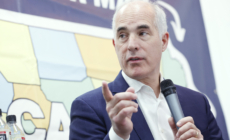-
Incoming LAPD chief’s proposed salary cut amid Police Commission drama - 32 mins ago
-
China Reveals $1.4 Trillion Plan to Bail Out Local Governments - 33 mins ago
-
Did Bob Casey Concede? Pennsylvania Senator Speaks Out as McCormick Wins - 34 mins ago
-
Sharon Horgan’s Uncertain Yet Brilliant Path to Apple TV+’s ‘Bad Sisters’ - about 1 hour ago
-
The election day freak-out: Some ways that L.A. is coping - about 1 hour ago
-
On the Ballot, Abortion Rights Proved More Popular Than Kamala Harris - about 1 hour ago
-
South Korean President Yoon Suk Yeol’s biggest problem isn’t North Korea - 2 hours ago
-
Hochman beats Gascón in Los Angeles County D.A. election - 2 hours ago
-
Trump Names Susie Wiles as His White House Chief of Staff - 2 hours ago
-
The Man Behind This Iconic Voice of The ’90s Has Died - 2 hours ago
California voters pass Prop. 2, state bond measure to upgrade schools

California voters approved Proposition 2, a bond to provide $10 billion in funding for repairs and upgrades at thousands of public elementary, middle and high schools and community colleges across California.
The Associated Press declared passage of the ballot measure on Wednesday night.
Voters rejected the last school bond proposition in March 2020, a $15-billion proposal that got only 47% of the vote.
Proposition 2 will provide $8.5 billion in facility renovations and new construction for K-12 schools, with 10% of the funds dedicated to small school districts. Community colleges will receive $1.5 billion.
The school bond was endorsed by both the California Democratic and Republican parties, as well as a coalition of more than 150 groups.
Many districts are already on a waiting list for the funds, with $3.4 billion approved for projects to repair hazardous mold, leaky roofs and septic systems, as well as to build classrooms, modernize science labs and replace aging buildings.
The cost to repay the bond will be about $500 million annually over the next 35 years, which will come out of the state’s General Fund. Because the state has to pay interest on the money it borrows, the total cost of the bond will be about 10% more (after adjusting for inflation) than if the state paid upfront, according to the Legislative Analyst’s Office.
To receive bond money, districts must raise a local bond of their own and then apply to the School Facility Program for a funding match on a sliding scale up to 65% for renovations and 55% for new construction — 5% more than previous bonds. The exact state match is based on a complicated points formula that seeks to provide a higher match to low-wealth districts that cannot afford to generate much local funding, and those with a high percentage of disadvantaged students.
Districts that are unable to raise more than $15 million can receive up to a 100% match.
Source link


















